Beautiful views, comfortable train cars, the bustle of busy platforms, and the thrill of a new adventure: there are a lot of good reasons to travel Europe by train!
But,for those of us who grew up in a place where traveling by train isn’t common, the prospect of train travel in Europe can be as intimidating as it is exciting.
Thanks to traveling Europe extensively for years (including with our dog!) and spending more than a year living in Portugal, we’ve had a chance to appreciate countless train rides through and across Europe.
From the mind-boggling efficiency of Swiss trains to overnight train rides through Eastern Europe (Sofia toIstanbulwas a particularly memorable ride) to simple jaunts across Italy, we’ve experienced just about every form of train travel in Europe.
And along the way, weamassed a huge number of European train travel tips!
This train travel guide is a culmination of everything we wish we would have known before we started traveling Europe by train, plus why we think it’s worth a try.
Table of Contents
- Who is This Guide to Train Travel in Europe For?
- Is Train Travel in Europe Right For You?
- Different Kinds of Train Travel in Europe
- Different Kinds of European Train Tickets
- How to Buy Train Tickets in Europe
- How to Receive Your Tickets to Travel Europe By Train
- How to Travel Europe By Train: Step-By-Step Trip Guide
- Useful Tips for Train Travel in Europe
Some links in this post may be affiliate links. If you make a purchase through one of these links, we may earn a small commission at no extra cost to you. Please see ourdisclosure policyfor more detail.
Who is This Guide to Train Travel in Europe For?
If you’re planning an epic, multi-destination trip and are hoping to travel by train through Europe but aren’t already comfortable with train travel on the continent, then this guide to traveling by train across Europe is for you!
We grew up in suburbs in the USA, and until we started traveling internationally in adulthood (4+ years offull-time travel, more than a year living in Lisbon,manytrips across Europe, and counting!), we had virtually never taken a train.
While that’s certainly not the case for many people around the world, it is for thousands of our readers who grew up in similar environments to us!
If you’re excited to travel Europe by train but are learning the whole process from scratch like we once did, you’re exactly who we wrote this guide for.
While train travel in Europe isn’t exactly the same everywhere–with over 50 countries and therefore over 50 train systems, there are plenty of quirks based on location–this guide to train travel in Europe will give a solid overview that will help you start your travels with confidence.
Is Train Travel in Europe Right For You?
Planes, trains, buses, rental cars, river cruises–with plenty of transportation options for getting around Europe, how do you know if train travel is for you?
In this section, we’ll break down the pros and cons of traveling Europe by train to help you decide if it’s the right transportation option for you.
Pros of Traveling Europe By Train
Taking a train across Europe is a bucket-list-worthy experience.
For most of us who hail from other places, this is the number one reason to book that first train in Europe, right?
Traveling by train through Europe tops plenty of bucket lists around the world, and for good reason: it’s an incredibly fun way to explore the continent.
On some routes, the train ride is a travel destination in its own right–and even when it’s not, it’s a cultural experience to remember.
… and can allow for spontaneity.
For some routes, especially those with fixed ticket prices (more on that in another section of this Europe train guide), traveling by train allows you to be spontaneous, coming and going from destinations with much less foresight than is required when taking planes.
Depending on where you are, it can be very scenic.
If you have daydreamed about staring out train windows in Europe as you watch mountains, streams, seas, villages, castles, and vineyards go by, let me tell you… that’s pretty much exactly what it’s like a lot of the time!
Obviously not everywhere on the continent is scenic, but if you travel Europe by train, you’re likely to experience some truly incredible views along the way.
Most train stations are in the center of the city.
In our opinion, this is one of the biggest benefits to train travel in Europe!
While most airports (especially airports servicing budget flights) are located far outside the city centers, train stations are generally located right in the heart of the action.
Step outside the train station in Cologne, for example, and you’ll be looking at the cathedral.
InFlorence, you’ll arrive less than a 10-minute walk fromthe Duomo.
In some places, like in Milan, Antwerp,Porto, and Paris’ Gare de Lyon, the opulent central train station is practically a tourist destination in its own right, so you’ll be exploring the minute you arrive, rather than spending hours getting into the city center from the airport.
No luggage limitations!
没有人会权衡你的行李或确认it is only a certain size on a train, so you can bring whatever you like (sports equipment and generally pets included).
Train travel in Europe is generally far more comfortable than flying.
At the end of the day, traveling Europe by train isimmenselymore comfortable than flying.
There’s less hassle, more comfortable seats, more ease of moving around, often better views, and more control over your environment.
If all else (price, time, etc.) were equal, we’d personally choose to take a train across Europe over a plane any day of the week.
Cons of Traveling by Train Through Europe
It can get pricey.
When you first set out to travel Europe by train, you may assume that it is more affordable than flying–but thanks to a combination of several factors, including incredibly inexpensive budget flight carriers in Europe, that’s actually not the case.
Typically, it’s cheaper to hop ona budget flight between two major European cities than take a train.
The severity of the difference, though, can vary dramatically, and there are lots of tips you can apply to your train travel in Europe to mitigate the cost, which we’ll cover in this blog post.
If you’re traveling long distances, train routes can take a prohibitively long time.
For example, when traveling fromParistoVenice, a route we’ve traveled by train, the train can easily take upwards of 10 hours, while the flight time is under 2 hours.
Now, that doesn’t account for getting to and from the airport, checking luggage, or going through security, all of which increase the amount of time a flightactuallytakes, but it’s still a large difference.
Train travel in Europe isn’t available everywhere.
As you move further into eastern Europe and the Balkans, train travel becomes much less prevalent (even popularDubrovnikisn’t connected to the rest of Europe by rail).
And, when it does exist, can take longer and be less comfortable than planes or even buses depending on the destination.
Rail strikes can derail plans to travel Europe by train.
Generally, these are planned in advance, so you’ll know what you’re getting into before arriving, but they can be a bit of a hassle.
We’ve had trips to both Italy and France impacted by rail strikes in the past.
If you have mobility issues, train travel can be difficult.
提升和储存行李,导航小污渍rcases and bathrooms, and making your way through crowded train stations can be difficult if you struggle with mobility, so keep that in mind when deciding whether to travel Europe by train.
This is especially true with a short connection–we once had to literally sprint through the station to make a connecting train on time in Germany!
Traveling Europe by train can be a bit intimidating.
This isn’t a con, exactly, but there’s no doubt that the confusion surrounding train travel in Europe can prevent new visitors to the continent from trying it out, especially if they’re concerned about language barriers or navigating multiple countries.
If that’s your only hesitation, though, we urge you to set those concerns aside.
T欧洲坐火车是一个极其rewardin剥落g experience, and well worth stepping a bit outside of your comfort zone for!
Different Kinds of Train Travel in Europe
When discussing train travel in Europe, it’s important to remember that not all trains are created equal, or exist for the same purpose.
Here are a few general train categories to keep in mind as you plan your trip.
Metro/Intra-City Transport
Metros, aka subways (though some do run above ground) are public transportation used by a certain city.
While they are technically trains, metros are their own category entirely and this Europe train guide doesn’t cover them any further.
Commuter Rails/Regional Trains
Commuter rails and regional trains aren’t exactly synonymous, but for the purposes of this guide, they’re similar.
These are slower-moving trains used to connect surrounding villages to a major city (for example,Versaillesto Paris) or trains that go within a certain country or region (for example, from Siena to Florence in Tuscany).
Most of the tips in this guide to train travel in Europe apply to these trains, but they sometimes have fewer amenities (like snacks/drinks available for purchase, for example) than high-speed or long-distance trains.
High-Speed Trains/Long-Distance Trains
These are trains that cover long distances within a country (for example, fromFlorence to Venice) or cross borders (for example, from Paris to Amsterdam).
Since each country runs its own train system (often with a national carrier option and private carrier(s) mixed in), booking a ticket between countries may mean changing train companies at a city near the border.
For example, when we traveled from Paris to Venice by train, we took a French SNCF train from Paris to Turin, Italy, and then boarded an Italian Italo-branded train to travel from Turin to Venice–all booked on the same ticket.
These high-speed and long-distance journeys are the primary focus of this guide on how to travel Europe by train.
Tourist Trains
These are trains that, while technically public transportation, are typically used as tourist attractions for sightseeing purposes, and are priced accordingly.
Examples include the Glacier Express or Schniyge Platte in Switzerland, or the Jacobite Steam Train (aka Harry Potter train) in Scotland.
Sleeper Trains
Technically, sleeper trains aren’t their own category–they’re just long-distance trains with sleeper carriages in them–but they’re worth calling out separately in this guide to train travel in Europe because they’re particularly interesting for travelers.
Not only are sleeper trains a great way to save on hotel costs for a night of your trip, but they can also be quite the travel adventure in their own right!
Different Kinds of European Train Tickets
Before you start looking into buying train tickets, there are a couple of terms to be familiar with:
First vs. Second Class Tickets
When traveling via train in Europe, you’ll generally have a choice between first and second-class tickets.
Buying a first-class ticket generally comes with slightly larger seats, sometimes the ability to reserve your exact seats when you can’t in second class (both of those facts vary based on the company you travel with), and possibly a small snack like a water bottle and a pack of cookies.
In our earlier travel years, we never used to consider these perks worth the money–but I’ll admit, as we started traveling with more luggage and most importantly, our dog Ranger, we started splurging on first-class more frequently.
The extra space can definitely come in handy if you have more than a suitcase with you!
Variable vs. Fixed Price Tickets
Variable-price tickets, as the name implies, tend to increase in price the closer your date of travel gets.
These tickets are generally used for high-speed trains and long-distance journeys and will be the most common form of ticket you see when traveling between countries by train in Europe.
Fixed-price tickets are more typical for regional (aka “slow”) trains and can be booked at any time–so you can just show up at the station and buy them from a kiosk without issue.
For example: if youtravel from Florence to Bolognaon a high-speed train, it will take around 30 minutes and that ticket has a variable price.
If you travel on the regional train that takes around an hour, the price is fixed and you can book it at any time.
How to Buy Train Tickets in Europe
When you travel Europe by train, one of the first things you’ll need to get the hang of is exactly how and where to buy European train tickets–and you have plenty of options!
Here are different ways to obtain train tickets in Europe.
Online (Via a Third-Party Site)
第三方预订网站wh非常有用en preparing to travel Europe by train, especially when you’re planning to travel between countries.
We use and recommendOmio, which will allow you to easily compare prices between different routes, show you the most efficient path, and allow you to book trains across Europe with no concerns about language barriers, iffy online translations of national websites, or issues with payment (some company websites struggle to process foreign credit cards).
Omiois a ticket aggregate, and searches multiple companies and routes at once, which makes it very handy for checking train timetables and possible routes as well as for booking tickets!
Searchtrain routes and tickets prices in Europetoday!
Online (Via the Company Directly)
Alternatively, if you’re looking for the best possible deal, you can book tickets online through direct websites for most countries in Europe.
For example, here are the national train company websites forItaly,France, andGermany.
We tend to book directly whenever we’re traveling domestically in a place we’re very familiar with, like Italy.
At the Train Station
If you’re traveling a short distance on a regional or commuter rail (like to take a day trip, for example), you can also buy tickets directly at the train station.
If you’re buying train tickets in person, we recommend using the kiosks available whenever possible.
Not only do they tend to have language options that make things much easier, butthey also tend to take a fraction of the time of waiting in line to be helped by a person directly.
With a Train Pass
The final option for booking tickets to travel Europe by train is to do it in one fell swoop witha Eurail pass(for non-European residents) or Interrail pass (essentially the same thing, but for European residents).
Essentially, a Eurail pass will allow you to buy a certain number of train rides (or an unlimited number) in advance, allowing you to be more spontaneous in your travels.
However, there are limitations–for example, some routes still require advance reservations and charge additional fees.
Generally speaking, the average user will end up spending more on train travel in Europe with a pass than without one.
There are cases where a train pass makes sense, though, so if you’re planning lots of European train travel, especially in Western and parts ofCentral Europe, be sure to run the numbers to see if a European train pass is right for you!
How to Receive Your Tickets to Travel Europe By Train
Once you buy your tickets, the next step is to actually receive them!
Here are the three main options.
Online
Most European train tickets these days can be received online and downloaded to your phone.
When available, this is by far the easiest and quickest way to receive your tickets.
At the Station
You can also choose to receive your (paper) tickets at the station you’re departing from, either by purchasing them there as mentioned above, or by picking up tickets you bought online.
In most cases, there’s no real reason to pick up paper tickets you bought online as opposed to simply downloading them, but most countries do still have the option.
At Home
If you book tickets to travel Europe by train well in advance of your trip, many countries do also have a home delivery option where they can be mailed to you before you travel.
We took advantage of this for our very first multi-country trip to Europe and had our train tickets for our overnight route from Krakow to Budapest mailed to our then-home in San Antonio.
Honestly, it was complete overkill, even as the novice travelers we were then, and we don’t necessarily recommend doing this–but some places do have the option available.
How to Travel Europe By Train: Step-By-Step Trip Guide
If you’re confused, concerned, or just slightly intimidated by train travel in Europe but are ready to book your first journey, this section is for you!
Follow these instructions step-by-step, and you’ll travel Europe by train with ease.
Book your ticket.
Generally, for long or inter-country journeys, booking online is the easiest option as we outlined above.
We use and recommendOmiofor booking train tickets in Europe.
Make sure your ticket is in hand.
This can mean downloaded onto your phone or printed onto a piece of paper in your hand.
Either option works in most places, but whichever you choose, make sure you have your ticket handy when you board.
Head to the (correct) train station.
Most major European cities are home to more than one train station, so be sure to double and triple-check that you’re going to the right one before you set off.
Find your platform.
Much like in an airport, your first step to finding your train platform will be to check the (often large, sometimes confusing) boards bearing destinations and times.
It’s best to search for your train based on a combination of the train number, company, and departing time–notthe destination.
If your train is continuing past your stop, for example, searching by destination can get very confusing, very quickly.
European trains (and Europe in general) also use the 24-hour clock (so 3:00 PM will be displayed as 15:00, etc), so keep that in mind when looking for your train on the departures board.
Validate your ticket.
If you have a paper ticket, you’ll need to validate it before you board.
The kiosks to validate your ticket are generally placed just before you reach the platform, but can sometimes be easy to miss if you’re not looking for them.
(As far as we’re concerned, this hassle is another point in favor of online/downloaded tickets.)
If applicable, find your train car and seat number.
If your train has reserved seats, you’ll need to find the exact train car number and seat number to sit in.
This is most common on long-distance, high-speed trains.
… Or just look for the appropriate class.
If your train has open seating, the only seating concerns will be whether you sit in the 1st or 2nd class.
The “1” or “2” denoting whether it’s a first or second-class train car is generally marked obviously on the side of the train, near or on the door itself, so it’s fairly easy to make sure you’re in the correct place.
Stow your luggage.
In some trains, this will mean storing your luggage in the racks provided at the ends of each train car, in others, it will mean in the racks above the seats, and in still others, there are even places to store bags between the seats.
Keep an eye on what others are doing, but keep in mind that as long as your luggage isn’t in anyone else’s way, there’s generally some flexibility to the process.
Settle in and enjoy the views.
Once you’ve found your seat and stored your luggage, it’s finally time for the best part of train travel in Europe: kicking back and enjoying watching the world go by.
No matter how many times we ride trains through Europe, we never stop getting a little thrill during this part of the process!
保持您的机票方便当售票员s by.
At some point, as you travel Europe by train–and it could be 5 minutes into your ride, 5 hours into your ride, or both–a conductor will come by to check your ticket.
Be sure to have your ticket in a convenient place so that you’re ready when this happens!
Listen carefully as you get close to your destination.
As you begin to get close to your destination, it’s time to pay very close attention to the announcements.
许多欧洲城市的火车站,像是d very similar to each other, especially to those not familiar with them (for example Roma Tiburtina and Roma Termini), and you’ll want to be certain to exit the train at the correct stop.
Otherwise, you might accidentally find yourself deep in the suburbs instead of in the center of the city!
In many places, especially along routes popular with tourists, arrival announcements for each station will be repeated in English, but that’s not a guarantee.
Exit the train quickly and smoothly.
When you reach your stop, be ready to exit immediately–that means luggage in hand and waiting at the end of the train car to exit.
You’ll generally see people start to queue up a few minutes before arrival.
The train stops long enough for everyone to exit comfortably, so you don’t need to push past other people or even hurry if you’re prepared.
However, ifyou wait until the train stops before even getting your luggage together, well–if your station isn’t the final stop, you might find the train moves on before you have time to get off.
Useful Tips for Train Travel in Europe
If you have your heart set on traveling Europe by train, plan ahead.
As youplan your Europe itinerary, you’ll likely find that some destinations are better suited for traveling Europe by train than others, and it definitely pays to know which destinations require a train, plane, or bus before arriving in Europe.
Train travel in Europe is generally best suited for certain Western and Central European countries–the further you move into the Balkans and Eastern Europe, the more limited (and, shall we say, adventurous) it becomes.
And, despite being situated essentially as far to the west of Europe as you can get,SpainandPortugalare surprisingly isolated from the perspective of train travel (this is due to having a different size of railroad gauge than other countries in Western Europe).
Distance also plays a key role.
Traveling from Paris to Venice by train is a long but completely doable day, but Paris toZagreb, not so much–that route is better suited to a plane.
Add in the fact that you’ll want to book your variable-price tickets in advance, and the bottom line is that you should definitely bank on planning at least the most important routes in advance.
Definitely book complex routes for train travel in Europe in advance.
If you’re traveling from Rome to Florence or Madrid to Barcelona, especially if you don’t mind taking a regional/slow train, you can book your train tickets once you already arrive in Europe.
For more complex or longer routes, though, you’ll make things much easier on yourself if you book before you start your trip abroad.
Bring snacks and drinks along for the ride.
While most long-distance routes will sell simple food on board like sandwiches, drinks, and pre-packaged snacks, the selection is generally about on par with airplane food, in other words, expensive and unexceptional.
Commuter and regional trains are much less likely to sell food on board.
On long-distance trains, there’s typically a dining car you can visit to make purchases, and on some routes (especially in first class), a restaurant cart will come around offering a few items, similar to a flight attendant.
Better not to worry about it, though: we recommend packing plenty of snacks (or even a full meal) and drinks to bring along, which is completely typical on trains in most places in Europe.
If you have a long train ride ahead, consider packing cards or a game.
Not only will this help entertain you throughout the journey, but it’s also a great way to meet other travelers!
Don’t count on having internet access onboard.
Even if you have a European SIM card and are traveling within the Schengen Zone (where SIM cards are supposed to work across borders), maintaining an internet connection on a European train ride is iffy.
Between tunnels, remote countryside, border crossings, etc., it’s best not to count on having access.
If the train advertises wifi, don’t count on that either–some of them require a local tax ID number or phone number to access.
We’ve found that our best bet for internet access during train travel in Europe is whenever the train briefly stops at a station.
If you have a SIM card that works for that destination, you can usually expect at least a few minutes of connectivity there.
Make sure you go to the correct train station.
We mentioned this above, but it bears repeating: be very certain that you go to the correct train station when traveling by train through Europe… and that goes for when you get on and when you get off!
… And show up early.
Some train stations in major cities are enormous, and can almost resemble airports, with 30+ platforms, various levels, and in some cases a mall inside them (like Roma Termini, for example).
If you’re not familiar with the station in question, be sure to leave yourself plenty of time to find your way to the correct platform once you arrive!
If you have an opportunity to take an overnight train, do!
Not only is it a great way to save on the cost of a hotel for the night, but spending the night in a sleeper car can be quite atravel adventure!
(Though in the interest of full disclosure, I have never once gotten what I would call a good night’s sleep on a train. No regrets, though, and we’ll do it again!).
Toilets are plentiful, but their quality is questionable.
In other words, bring some toilet paper (I usually keep a small packet of tissues handy for that purpose) and hand sanitizer.
Also, wet floors aren’t exactly unheard of, so you might want to stick with close-toed shoes.
Most high-speed trains in Europe have a toilet available in every train car, so you typically won’t need to go far to find one.
If you’re a student and/or under 26, you might qualify for discounts.
Keep that in mind when booking your train tickets for Europe, and if you do book a discounted fare, be sure to keep your ID handy (it’ll likely come in handy in many other places during your trip, too).
Keep in mind that some under-26 discounts are only available to EU residents, so be sure to verify that before counting on them if you aren’t European.
You can generally bring dogs (and cats) with you on trains in Europe!
This is a bit beyond the scope of this blog post, but given that we have several photos of Ranger in here, I’m sure at least a few readers are curious!
The vast majority of trains in Europe allow well-behaved companion animals on board, with varying requirements and costs (generally either free or the price of a child) based on the animal’s size, whether it’s confined in a carrier, etc.
It’s best to check the expectations for each route in advance, but with a little planning and flexibility, your furry friends are generally welcome.
Ranger is quite the traveler and has visited 8 countries and counting with us, many of them by train!
Keep an eye on social norms.
Cultural expectations around eating, talking loudly, and storing your luggage can and will vary depending on where your train travel in Europe takes you.
Be sure to keep an eye on what everyone else is doing to ensure you’re not inadvertently committing a faux pas!
For example, if you take a train, say, in Italy and then later in Austria as you travel Europe by train, you’ll likely notice a huge difference in the noise level on the train!
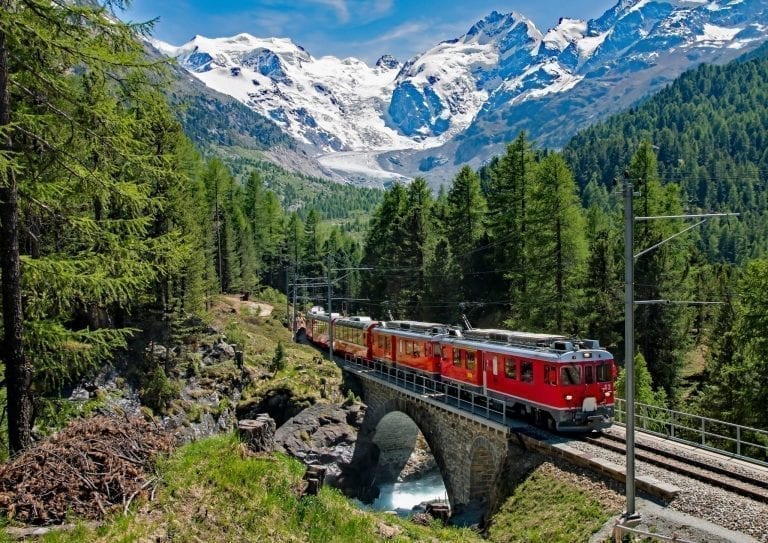



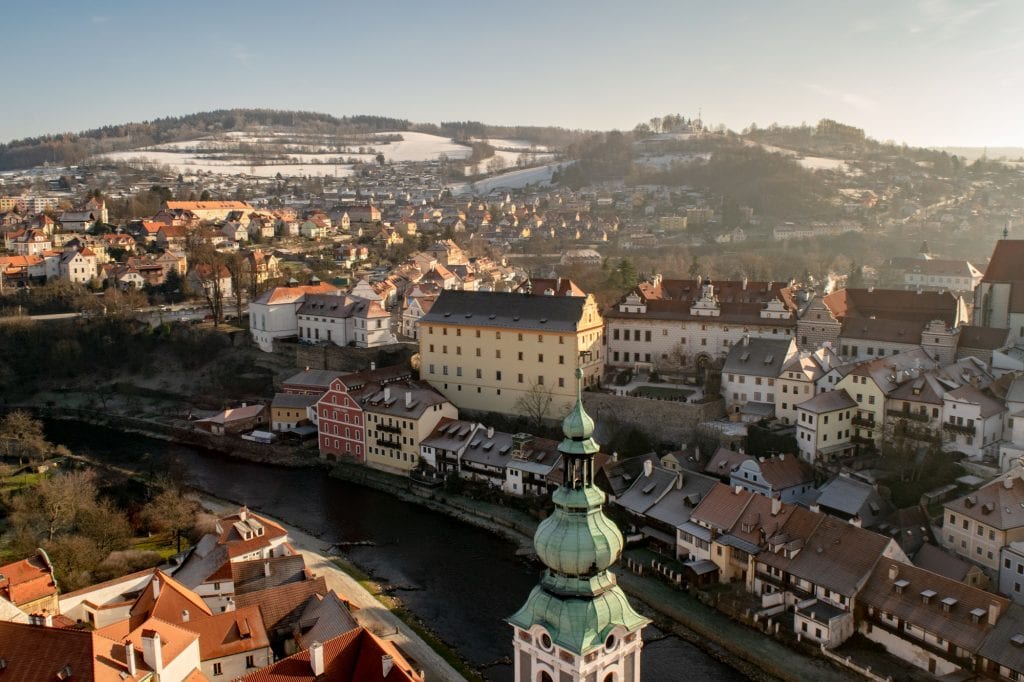


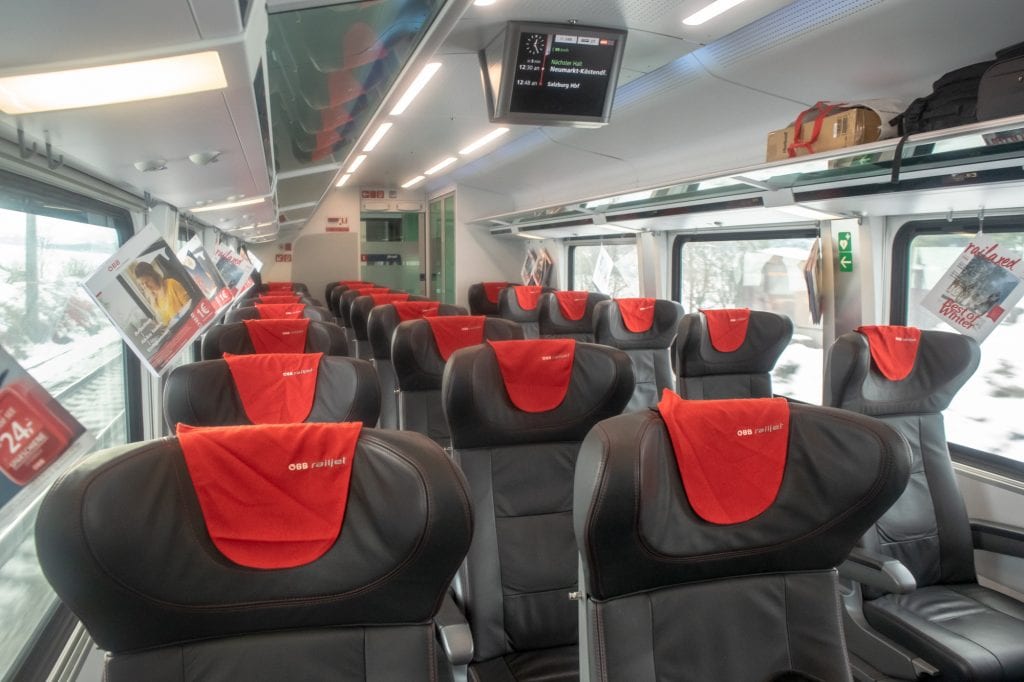
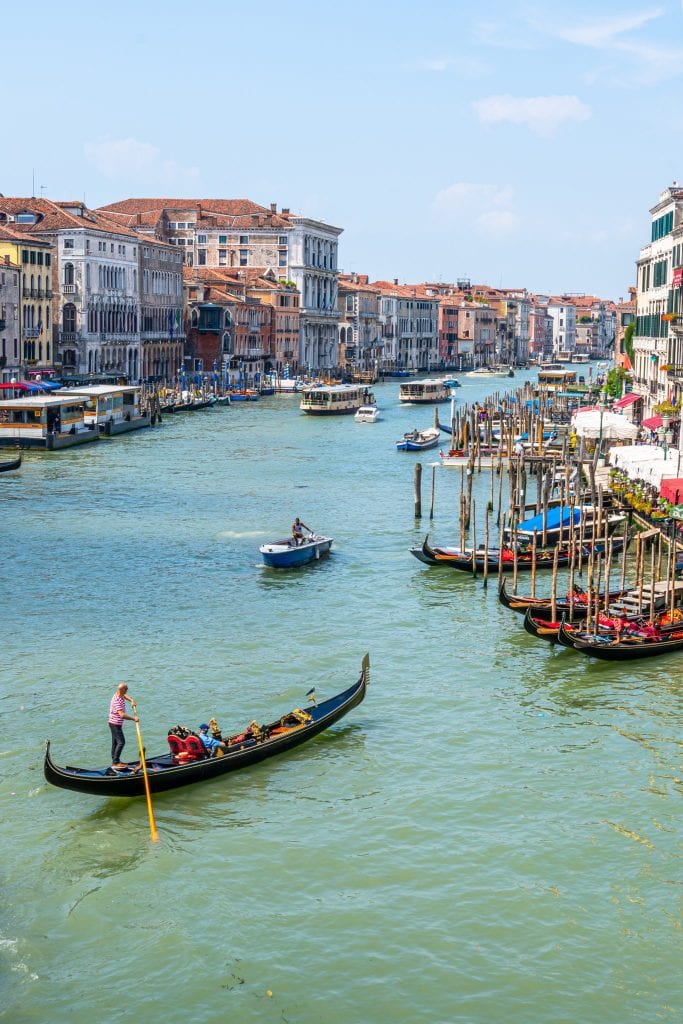



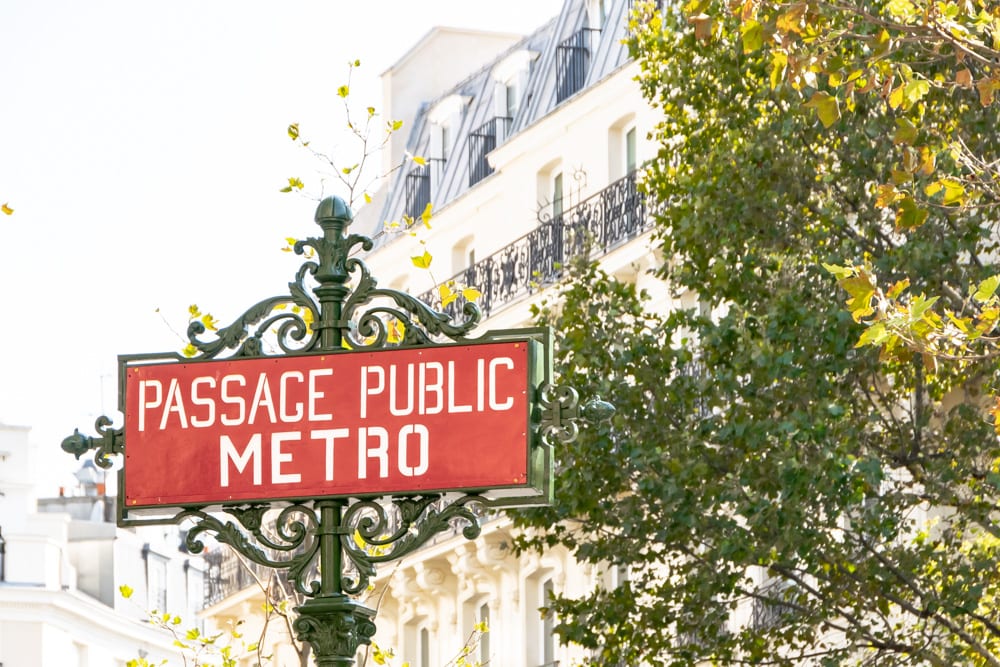
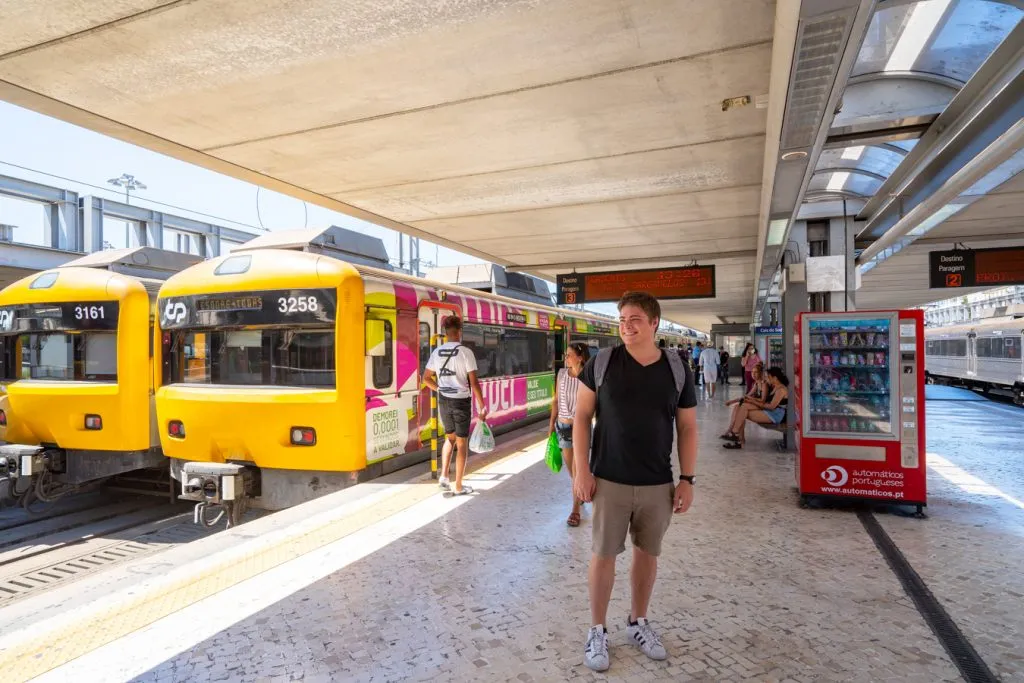









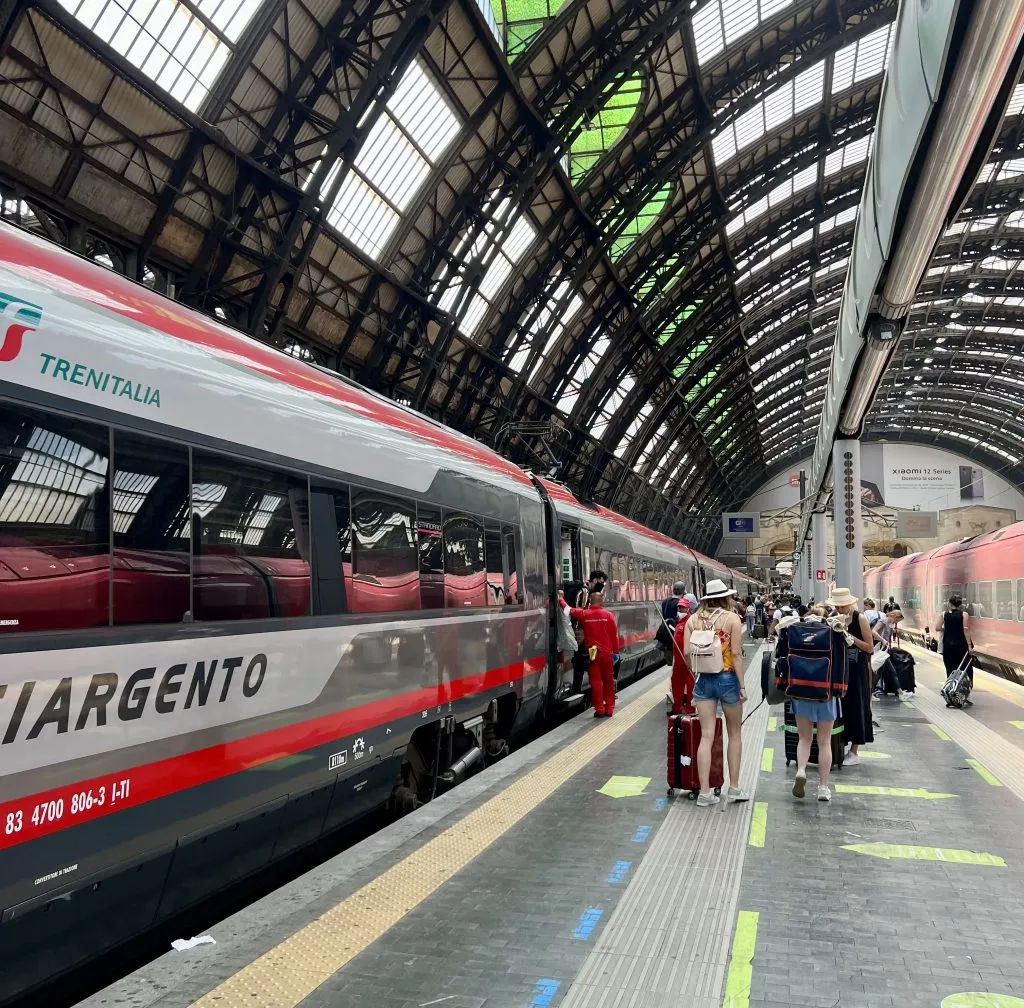





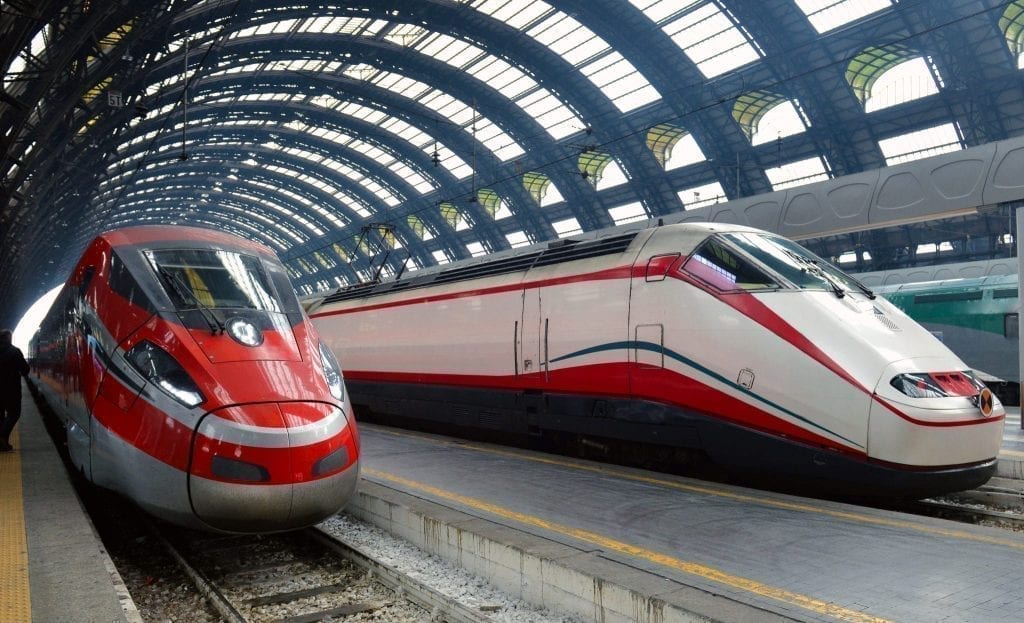
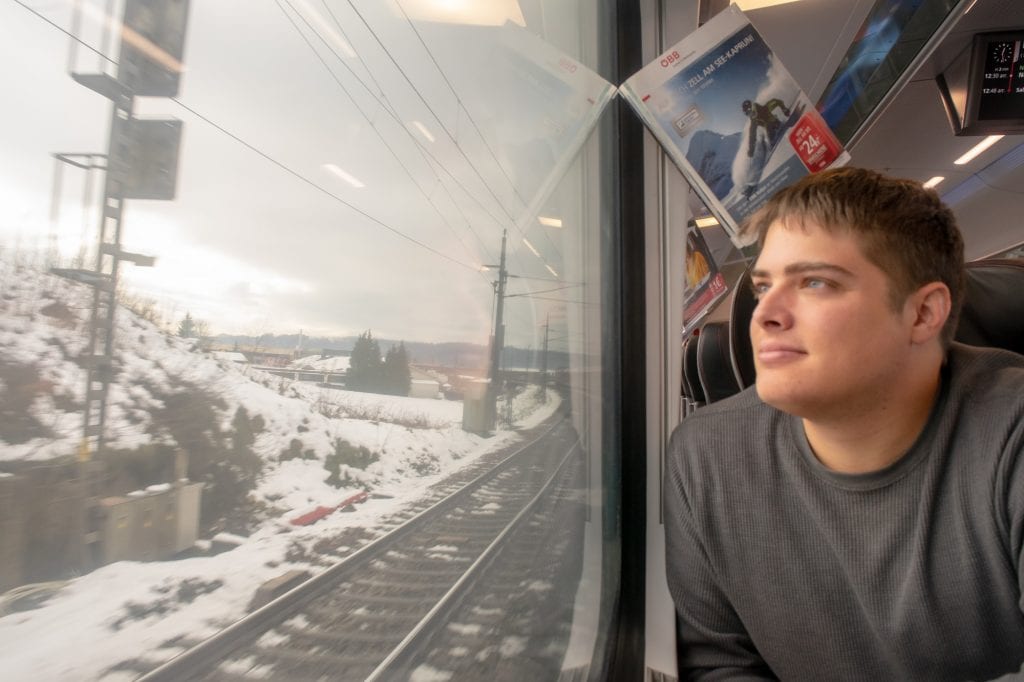






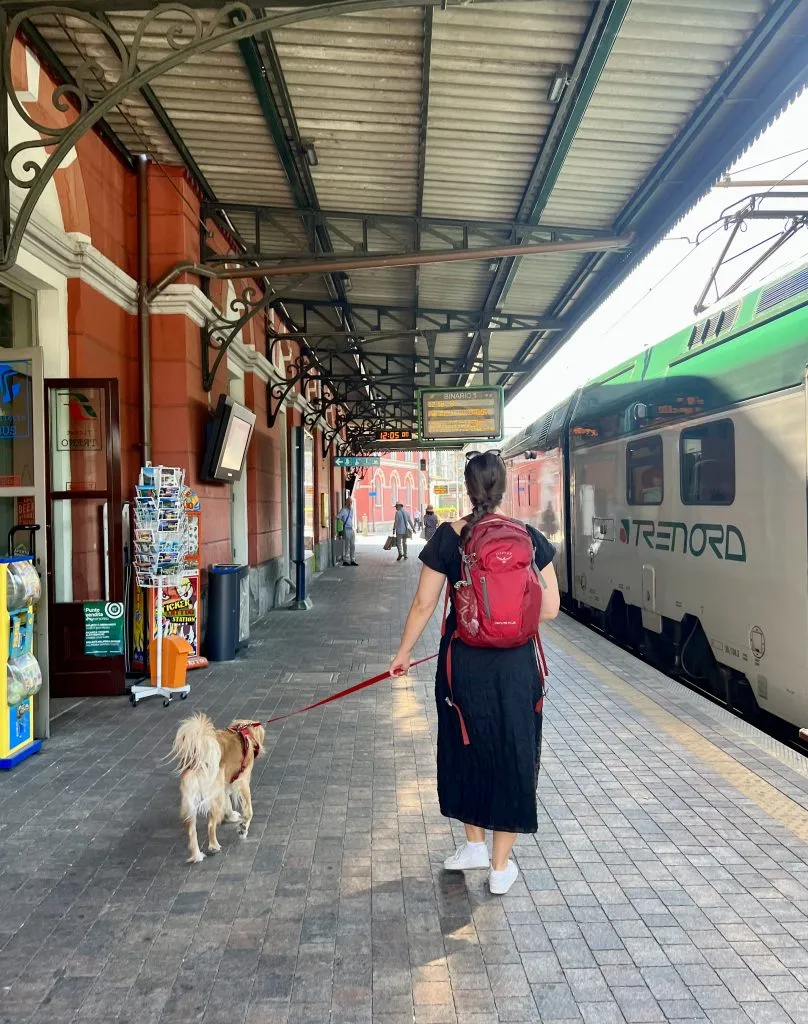

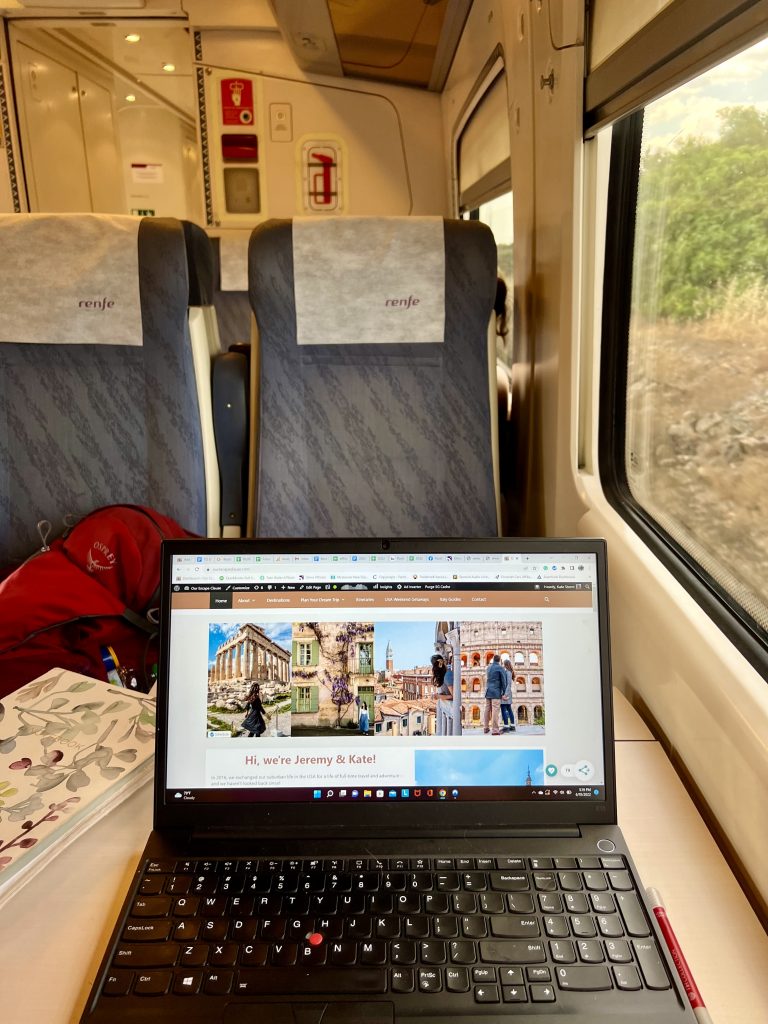



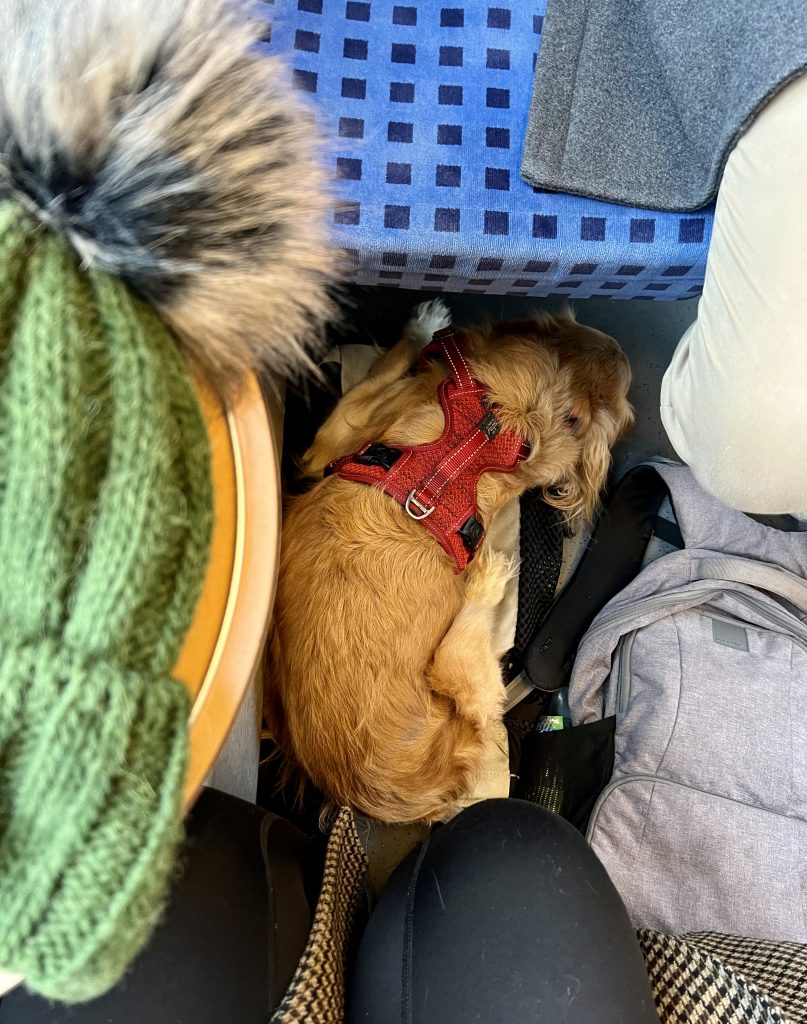


We are senior citizens planning a trip to Italy and surrounding areas in September 2022. Looking at some train travel, multiple cities for sight seeing. We like the smaller, picturesque, historical cities. What advice can you offer?
Hi Jane!
I definitely recommend searching “Italy” on our search bar (top right of the site on desktop, part of the menu on mobile). Italy is one of our favorites and we have (literally) about 100 posts about it!
For small, picturesque, historic cities, Siena, Venice (it is pretty small!), and Verona come to mind. Florence, too–surprisingly small in some ways!
For even smaller hilltop villages like Montepulciano, etc, in Tuscany, be aware that many of the train stations aren’t in the town center, so you’ll likely want to catch a taxi in many of them to avoid hauling luggage up a hill.
Two years ago we had a small villa in a very small town in Italy. We trained to a new place everyday. It was funned and easy. We took the local bus into the next target town, bought our tickets at the station and took off for the day. We went to Florence, Pizza, and several smaller towns. We are mature seniors and had no trouble getting around. Only a couple of people spoke english in a small town, but, we managed easily.
Thanks for the helpful information. Appreciate it!
My boyfriend and I just booked our first train tickets in Europe thanks to you!!! I’m so happy we found your blog. We’re going to France and Spain this summer!
Ahhh that is wonderful to hear! Have a fantastic time!
My wife and I, both 70 are taking a cruise from Budapest to Passau and plan on taking trains to Birmingham England from Passau. I’ m planning about 5 stops. First Venice then Tirano, St. Moritz, Sion, Strasbourg and finally Birmingham. I plan on a Eurrail pass. do you have any advice, help or suggestion.
Thanks
Hi Wayne! If you’re planning on an Eurail pass, my best advice is to research your routes, dates, and times in advance–many popular routes will still require advance reservations even with a pass.
Kate, my wife and I are planning our first cruise in Europe, and are thinking about taking the train from Barcelona to Rome (cruise departure). Your blog was a great overview. My question has to do with ability to get off and on a subsequent train, for day visits on the way. Is switching covered or individually arranged ahead of time, and is it a good or bad idea for novice mostly monolingual travelers to Europe? Advice? Thanks,(Chuck)
Hi Chuck!
If you book a ticket from Barcelona to Rome, your ticket will be good for that specific train/departure only, so you can’t get off and back on at various stops. If you want to stop places along the way, you’ll need to book individual tickets between each destination you plan to visit.
If you have your heart set on that, look into an Eurail pass–it does what you describe, however, it can get confusing (some routes still require advance reservations) and will usually be more expensive than booking tickets individually.
Traveling by train is absolutely doable as a novice traveler, but be sure to be careful when you’re booking your tickets (to ensure they’re the right dates/times/train stations you expect), and pay close attention to the stops to ensure you don’t miss yours.
Another option, if you’re traveling during the summer and want to get from Barcelona to Rome quickly without flying, would be to take a ferry to Rome and then train to a few places around Italy from there.
Hope you guys have a great trip!
Kate
Hi,
My family is looking to travel from Lille to Amsterdam. My question is: when we depart out train that originated in Lille and transfer to a new train in Brussels, will we need to go through some form of customs before we board the train for Amsterdam? I just want to get an idea of how much time to leave for connecting trains.
Hi Matt! No customs required–all of those countries are part of the EU Schengen Zone, so moving between them via train is generally as seamless as road-tripping between US states.
And, is 33 minutes to connect from one train to another a lot of time? We have never done this type of thing before so I’m not sure if that is cutting it too close
33 minutes should be okay! Definitely move with purpose to find your next platform once you arrive, but you shouldn’t be in a huge hurry as long as everything is on time.
Kate- I am considering coming to Europe early for my Christmas river cruise heading out of Brussels. I was thinking of taking the train from the Brussels airport to Koln to see their markets and explore, and then doing a day train up to Dusseldorf to see their Christmas markets. It looks like about a 2 hour train ride on Thalys to Koln and then only about 30 minutes from Koln on to Dusseldorf. I will then take the train back to Brussels for my riverboat cruise. Does this sound feasible?
Bob Burch
As long as the timetables work in your favor, I don’t see why not! Germany and Belgium are both great countries for exploring by train.
Hello Kate,
We are looking to visit Italy for the first time in December/2022, I was looking in the train tours, visiting 4 cities (Rome, Florence,Venice & Naples). Your thoughts on train tours? Thank
Hi Sharon! I’m not sure what you mean by tour–if you mean a guided trip, they can of course be very fun with the right group, but I wouldn’t say you need one for this route.
All of those cities are very simple to visit independently by train, and we have taken trains to and from all of them many times (I’m actually typing this on a train to Venice).
Hi Kate, my husband and I are planning to fly in to Italy and travel by train to the following places:
1) Milan
2) Switzerland
3) Vienna
4) Prague
5) Paris
May I know if these places can be connected by train. If yes which train will you recommend, please. We are actually thinking about 15-20 days to cover these areas. As it’s our first Europe trip, do you think it’s sufficient and is there any place along the way that you would encourage to go.
Thank you.
Hi Von!
Yes, those are all excellent destinations to visit by train, so you’re good to go there. As far as specific trains, you’ll need to pull up the individual routes to check (we recommend Omio for this, especially with cross-border trains).
That’s definitely too many places for 15 days, though, and still pushing it at 20. I’d recommend trimming the itinerary a bit if you can (or adding on extra days, of course!).
Hi there
This was so helpful. My husband and I are going to Amsterdamin September and then 3 nights in Bruges. All us booked but I’m overwhelmed but the trains websites. Omio is the easiest but I’m still leary. Is it legit and a decent safe way to book trains? We are only going to Belgium. Then two days to the countryside in The Netherlands which we will just grab a regional train. Everyone is telling us to book the train to Bruges. Any helpful advice would be great. We would go to Antwerp and take an IC train to Bruges an hour later,as my husband does have hip and knee problems. Thanks in advance.
Hi Elaine,
I understand, it’s a lot to take on the first few times!
We use Omio regularly, as do many people we know, it’s perfectly legitimate.
The Antwerp train station will be a beautiful place to rest for an hour. It’s absolutely stunning, especially the front foyer, and often pops up on lists of the best things to see in the city!
Hi Kate,
My husband and I will be traveling from Prague to cities in Austria and Germany by train next month. We have used trains a few times in Europe before, but it was pre Covid. It looks like most Covid restrictions have been dropped, but I wondered if you have to show Covid vaccination cards on the trains?
Thank You,
Jaymie
Hi Jaymie,
I’m always hesitant to answer questions like this because I feel like I’ll be summoning disaster with how quickly things can change, LOL.
But at the moment, no, you won’t need your vaccination proof in either place as far as I know.
Life is pretty 2019 these days when it comes to the logistics of traveling around Europe as a visitor, though a handful of places still require masks on public transport (I think Vienna is one of them, but again–things change!).
This is so helpful, but I’m striking out with trains from Naples to Rome? It says that there aren’t any? Why would they list it as an option if they don’t travel to there?
同时,是否有办法预览火车多久rides are to decide if we want to travel to certain cities? Cannot find any train tables.
I find the Omio and Eurail sites to be difficult to navigate and I can’t get enough information to plan! Does it make sense to buy a eurail pass first and then research times and etas? Any help is appreciated!
Hi Suzy,
Trains from Naples to Rome definitely exist! It’s possible you’re looking too far in advance to book the tickets–on Omio right now, it looks like I can purchase Naples to Rome tickets up to about 6 months out.
When you search for a specific route on Omio, Trenitalia, etc, it’ll show you how long the train is and how many changes there are, if any, much like searching for a flight.
我们不推荐使用谷歌工具,as it tends to default to how to get somewhere if you leave at that second, which can be confusing and normally involves a more complicated route than you need.
Personally, we don’t generally find Eurail passes to be worth it in terms of cost-savings for most travelers, but in terms of research, you’ll be working with the same information either way.
Hope that helps! It can be a bit confusing at first, but if you try practicing by looking at dates sooner than when you actually plan to travel, I think you’ll find the information you’re looking for.
Hi Kate!
Thank you for taking the time to write all that useful information. It is so much appreciated by many of us!
Like many of your readers, we are (two young adults) planning to visit Europe for the first time this upcoming May. We are currently looking at:
Landing in the morning in Prague, spend 1 or 2 nights, then Vienna, one night, leave following morning for Bratislava (this one is a maybe, it’s so close!) OR Vienna to Venice. Spend 1-2 nights, then Zurich, and finally Munich, before we make it back to Prague to catch our returning flight. We are looking at 9 days from the morning we land. We figured it would be more efficient to travel in a circle, as some destinations -like Paris- will be out this time around.
Thoughts on that? I will look into Omni regarding trains, but our plan is to travel only by train, if possible.
I know that’s a lot of questions, but THANK YOU so much for your help!
Thanks so much, Al! So glad to be helpful.
You definitely have the right idea with traveling in a circle, though I definitely recommend trimming some destinations!
With 9 days, I’d suggest no more than 3 base cities (and that’s pushing it), and you can add a day trip or two from there if you like.
I know it’s SO tempting to add more places (I have this problem constantly myself lol) but you’ll have much more fun with a bit of time to explore each place!
I’m not sure what your priorities are or what your budget is, but based on the cities you listed, I’d cut Zurich (Switzerland is amazing, but you don’t have time) and Bratislava. Ideally, I’d suggest cutting one more city as well.
If it were my trip, personally, I’d do a Prague – Venice – Munich triangle, and potentially day trip to Neuschwanstein Castle or somewhere else in the Bavarian Alps with one of the days in Munich. That’s just personal preference, though!
You can definitely do all the destinations you listed by train, no issue there at all.
That recommendation sounds amazing. The two big ones are Prague (#1!) and Venice, but really hoping to do Munich as well.
I will look into the Bavarian Alps, as I am not familiar with them
Thanks again. Really enjoy reading through your content!
If you love mountains and/or castles, you’ll definitely love them!
Enjoy some Czech beer for us
Hi, we are doing Europe by train in June.
Is there a way to determine:
a. which direction the train(s) are going, so we can face forward?
b. Which side is considered the right side (vs left side) for best views when recommended?
Thanks for your perspective.
Hi Dave,
Unfortunately, there’s no clear-cut way to determine which way trains are facing, especially because they often turn around during the route, depending on how they pull into/out of various stations. On long journeys, it’s not uncommon to find yourself facing forward part of the time and backward part of the time.
If you’re starting from the beginning of the line, you can sometimes tell which way you’ll be facing at the beginning based on the route, but not always.
The same goes for the views–for very specific routes, you can sometimes get personalized recommendations from others who have traveled the route (especially for particularly scenic ones), but there’s no simple solution to figuring it out beyond just recommendations.
It’d certainly be easier if that were the case!
Hi Kate,
Really enjoying your posts, photos, and appreciate the helpful advice.
I am planning a trip in Sept/Oct to visit Scotland for a week before traveling in southern Germany and Austria. What would you recommend about getting from Scotland/London to Koln, Munich or Frankfurt? Is there a good train route to take? Or is this a case where flights make more (economic or time) sense?
Thanks for any pointers!
Hi Wendy,
That’s definitely a route that is better served by flight, both from an economic and time perspective!
Is there something I am missing about Omio, the booking site that you recommend?
My wife and I are moving to Lyon in April and plan to go to Amsterdam in May. I went on the Omio site just to get a sense of what was available from Lyon (Gare Part Dieu) to Amsterdam (Centraal) on a random date (I picked May 9) and the site told me it could not find any trains between these places. But on the Rail Europe site, it showed a slew of trains available throughout the day.
I am confused.
Hi Joe,
I am too, I’m not sure why it’s not coming up! I just did the search myself and played around with dates, destinations, etc. Paris – Amsterdam, for example, seems to be pulling up just fine.
Could be as simple as a bug, but I just shot Omio an email asking for clarification.
Hi Kate I am Josh from KL Malaysia looking forward for europe trip in september 2023.
I would like to start trip from berlin to budapest for 15 to 17 days.how to go about it by using eurorail?
Hi Josh,
Eurail has a website with a planning tool that can help you sketch out your journey.
Generally, you’ll buy either a set number of travel days within a given time period (like 7 days to be used in a month) or an unlimited pass.
Many routes do still require advance reservations (with additional fees), so be sure to check each route individually so you don’t miss anything!
Hi! I would love to travel as comfortably with my dog as you have, seeing from the pictures. I have a couple of questions:
1) what’s the name brand of that pet carrier. Looks perfect for mine.
2) Could you post tips on hoe to travel with your pet successfully.
Thank you for your content!
Hi Dannia,
Yes, absolutely–with a catch (if you’re in the US). We bought the bag on Amazon Spain when living in Portugal and don’t know of an equivalent here. But this is the link:https://www.amazon.es/-/pt/gp/product/B00XR2D94W/ref=ppx_yo_dt_b_asin_title_o07_s00?ie=UTF8&fbclid=IwAR3p0Ihrxf6e1yL4nJv5pJBK0GXmOIVIqXL97ov77VRuxSIvm61M2-NbfQE&th=1
Here’s Ranger’s backpack that he gets carried in as well (size large):https://www.amazon.com/gp/product/B07C9XLXVH?ie=UTF8&th=1&linkCode=ll1&tag=ourescapeclau-20&linkId=813c9a64c05de1faef0162cbed102f22&language=en_US&ref_=as_li_ss_tl
He absolutely loves both–gets so excited when we get his bags out, and climbs right in when we get onboard!
必威体育官方登录坐火车旅行的狗通常是在欧洲pretty simple, but you’ll always want to look up requirements for the specific country/train company (some require dogs not in a carrier to pay a half-fare or child’s ticket, etc).
If your dog is very small (like a yorkie or similar) they’re usually free, though again, be sure to check in advance.
I have it on my list to write a whole blog post on this topic eventually, but I hope that helps get you started!
Just wanted to say thank for you for such amazing content. We are starting to plan a 5 week trip to Europe for Summer 2024 with our 4 kids and your site and recommendations are beyond helpful.
Thank you so much, Megan! That’s wonderful to hear. Hope you guys have an incredible trip!
Hi, planning a trip to Europe with the family. Have been to Italy, Spain, Portugal, France and UK so we are looking for something different. Like Berlin, Prague and Vienna or Amsterdam, Berlin and Brussels. Love to get your thoughts on these routes and would you recommend taking the train between these cities?
Or any other 3 cities you recommend we do over 10 days.
Thanks
Hi Bobby,
Sounds like a very fun trip! All of the cities you mentioned are definitely doable by train, but Berlin-Prague-Vienna is more cohesive than Amsterdam-Berlin-Brussels (I also personally would put a couple of dozen other cities in the region ahead of Brussels, though it definitely has things to offer!).
Since it seems like Berlin is a priority for you, I’d recommend using that as your anchor and spanning out from there.
A few other places that could make sense, if you want to add more options to your list, could be Krakow, Budapest, or Bratislava.
If you want to start in Berlin and include Amsterdam, you might look into Hamburg, Cologne, or Bruges.
You could also head south from Berlin, and do a Berlin-Munich-Switzerland (Zurich or Lucerne if you’re looking for cities) route.
Really, the possibilities are endless, so it just comes down to the cities that call to you the most!
We are seniors, experienced travellers but novice on trains. We have 3 weeks to visit Paris, Prague, Vienna, Bern, Marseilles, Barcelona, and Lisbon. What suggestions can you offer us
Thanks
Hi Ray,
My first recommendation would be to trim a city or two–3 days per city is a very fast pace to keep up for 3 weeks!
Lisbon and Barcelona are of course the biggest geographic outliers. Lisbon is a non-starter as far as train travel to the rest of these cities is concerned–realistically, it’ll make more sense to fly to and from there.
Barcelona is a bit tricky, since Spanish and Portuguese trains are on a different rail gauge than the rest of the countries on your list. You can take a high-speed train from Barcelona to Paris, but getting from Barcelona to Marseilles via train is much more challenging than you’d think it would be based on a map.
The rest of the cities you mentioned are very well-connected by train, so you shouldn’t have any issues there.
Really informative site you have here!
I’m from Asia and planning to visit Europe for the first time in Oct 2023. I’ll likely start the tour from London and have about 10 days, then will fly home from Heathrow Airport London. I’m really into trains and would love your advice on what some destinations would be possible. I’ve never been to Europe so anything is fine with me. Thank you
Hi Oliver,
Honestly, the number of options is so overwhelming that you’re going to want to narrow it down–a lot!
Assuming you plan to hop over to mainland Europe (as opposed to heading north to Scotland, for example), Paris and Amsterdam are both great jumping-off points connected to London by train.
From either city, you can then reach dozens of cities within several countries in a day’s worth of train travel (or less).
考虑看看你感兴趣的地方in France, Germany, Italy, Switzerland, The Netherlands, and Belgium–just to name a few!
If you want to peruse some sample itineraries, we have several in this post://www.afriqueevents.com/2-week-europe-itinerary-trip/
Hope you have a fantastic trip!
Thanks for all the info contained within this blog.
We are planning for summer 2024,a 2-week tour of Europe starting and finishing in the UK.
How many stops would you recommend? Where would you suggest?, need to combine, beach, sightseeing and something in the Alpes?
Ive got in mind Uk – South of France – Italy- Budapest-Krakow – Germany(or similar)-UK
Now for the tricky bit, we are planning to do this with around 20 Explorer scouts!
Any tips for travelling in groups?
Can you also recommend a great website for hostels
Thanks in advance
Hi Simon,
Sounds like quite the trip! 20 scouts–you guys have your work cut out for you, but I’m sure they’ll love it. Can’t offer much personal insight in that direction myself, but I commend you guys for taking it on.
With only 2 weeks, I’d recommend 3 stops, with an additional day trip or two to add on more destinations. Sticking with the UK – South of France – Italy might work best in your case. Germany and Switzerland would also work as potential substitutes as they’re geographically close (depending on where you go).
We go into a lot more detail on putting together a 2-week itinerary in this guide://www.afriqueevents.com/2-week-europe-itinerary-trip/
As far as booking lodging goes, we tend to book all of ours through Booking dot com these days. For hostels in particular, Hostelworld is also popular, though we have rarely used it ourselves. Depending on how old your scouts are you might want to double-check any age requirements for dorm stays.
We are a couple in our 60’s who have travelled by train in Italy and Japan .We are travelling to Greece for 2 weeks then flying to Hamburg.From here we are going to travel straight to Berlin(3 nights),Amsterdam(3 nights),Paris (5 nights),Interlarken,Switzerland (3 nights) then to Munich(4 nights).
I have just started researching the best way to purchase rail tickets either a Eurail pass or point to point on Omio.Considering our itinerary what do you recommend?I have read that a Eurail pass is easier than point to point bookings but may be more costly.
Thanks for your blog,very informative.
Hi Francine,
In our experience, Eurail passes tend to be a bit more expensive for most travelers. Part of the reason for this is that many popular routes still require advance reservations that require you to commit to a date and often pay an additional reservation fee.
We have used an Eurail pass in the past, but these days, we always choose to book point-to-point journeys.
However, the only way to know for sure about your route in particular is to plan your trip out via Eurail (be sure to double-check what routes require reservations) and as a point-to-point trip and compare prices. Every trip is different, and since the prices for high-speed trains change depending on when you book them, there’s no way to know for certain.
If you’ve been comfortable traveling by train in other countries in the past, I wouldn’t say the ease of using an Eurail pass is worth the probable extra cost, especially with how simple it is to book train tickets online these days. It does depend on the traveler, though!
Thanks for the information
Travelling to krakow then Prague Budapest and Croatia. Have 2 month. Would like to travel by train
How far in advance do you need to book train tickets as I want to do it leisurely and not book to far in advance. Also what other country’s/cities do you recommend
Thank you so much
Betty
Hi Betty,
For most routes in that area, booking as you go (a few days to a week or so in advance) is just fine, as long as you’re a bit flexible. Exceptions can include night trains and traveling over holidays, so keep that in mind!
Keep in mind that train travel in Croatia is much less expansive than you might think–Dubrovnik doesn’t even have a train station! You can use some train routes, like Zagreb to Split, but plan on adding in buses and/or rental cars (plus ferries, of course) depending on where you want to go in Croatia.
With 2 months to travel from Krakow to Croatia, you might also consider stops in Austria (Vienna is right along your route), Slovakia (Bratislava is very easy to reach) and Slovenia. Depending on how direct you want to travel, Bosnia and Herzegovina could fit in as well.
这只触及possibili表面ties, but hopefully it gives you some ideas!